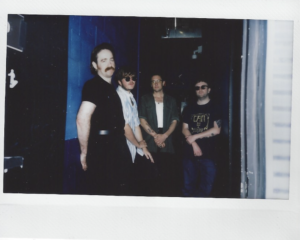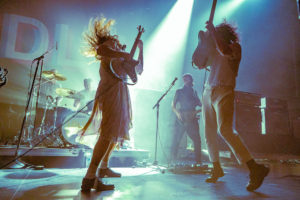
Hypocrisy On A Crocodile
Get your mind out of the gutter: the artist currently known as gilf! has more on her mind than your-mom jokes. Often political, hardly partisan and always with a curious combination of urgency and suggestiveness, the oeuvre of gilf! is a refreshing departure for New York street art – most recently making its Dumbo Arts Festival debut with a signature make-you-look-twice eye chart.
Gilf!’s particular brand of social wake-up calls took root in the Bush era and has since taken the form of spray paint, wheatpaste and installation work, ranging in subtlety from a stenciled image of the Abu Ghraib prisoner to optical illusion-type graphic works with hidden messages. This is hardly a body of work with an intentionally disingenuous “what’s it all mean?” pretense. Indeed, the point is almost always hidden in plain view, however angsty that may sound.
If you didn’t get a chance to come out to Dumbo, gilf! has also been busy making cameos on the occasional podcast or two, as well as working on private commissions, ICRAVE’s Imprimatur event, and a spectacle she cryptically describes as “something that seems to be glowing” within “our over-surveilled public spaces.” Luckily, she had time to entertain some of Alt Citizen’s emails as well.
Look around; soak it in. If you’re not pissed yet, you will be.

The Ghost of Gold.
It’s a little difficult to find too much about your work online without having to navigate through reams of XXX content. Was this an intentional part of choosing your artist name, or is it sort of an unintended consequence?
My poor mother, no. gilf! was a word that I dreamed up with two of my girlfriends when I was in elementary school. Long before the mindless drivel of the American Pie era, gilf! was a word, that to us, represented creative child’s play, a secret bond between friends, and a sense of mischief. We used it to speak in covert ways, almost as a placeholder in conversations to keep our communications private.
When I first started out doing uncommissioned public work in 2008, I went through so many monikers, but nothing felt right. The gilf! concept came up in conversation and it was an instantaneous “A HA!” moment. People always ask “why gilf!,” and I’m glad they realize there is more to my work and name than just a shameless grab for attention. It’s interesting as my work evolves to see how the original thought behind gilf! continues to permeate throughout the concepts I explore.

Circus Is Slavery. “I put [it] outside of the Barclays Center while the Ringling Brothers were in town; gag.”
I’m fascinated by how easily the general public is manipulated by advertising, the “news,” and governmental agencies. There are so many subversive ways we are inculcated to buy, consume, or absorb brands, ideas, and policies. I see most forms of these communications as visual manipulation that ultimately affects us on a subconscious level. I’m interested in the messages that are sent in this way, and am curious if I can use the same effects but to create a positive shift. By creating images that people may not “get” at first glance but absorb subconsciously, I feel the concepts embed themselves in the psyche and perhaps can contribute in a way to a subconscious awakening that I feel our society so desperately needs.

American Dream. “If you look in the background you can see the word UN and within the screws it says ‘sustainable.’ I did that last year for the Fountain Art Fair for Art Basel Miami. We estimated it’s about 17,000 screws.”
What’s the biggest difference between a basic piece of typography and a cryptic piece (like in I Exam) that makes the viewer work to uncover a hidden message?
Standard typography is meant to be very direct. You look at it, you get it. When you have to engage with the piece, stop and work to understand what it’s saying, you are exerting effort. There is something very rewarding about working on a problem until you find the solution. I’ve always thrived on problem solving. I think it’s rare and gratifying to feel that sense of accomplishment when looking at art work. I love it when my friends stare at my work in silence and then excitedly say “I get it!”
What sorts of techniques do you use to create them? Is there a digital program that does this or is there a way to use hand-drawn illustrations to trick the brain?
I do a lot of writing and thumbnail drawings in my sketch book, then switch to Illustrator and play around with widths, dimensions, and layers within the program to get the image looking right. It’s definitely possible to do it by hand, but I am a child of the Illustrator age and my obsession over detail and precision is best coddled by a machine.

Accept Nothing.
Where does “I Exam” stand in relation to your previous exhibitions?
My previous gallery work was very much based on my street work, which I create to be understood almost instantaneously. I EXAM is a strong pivot away from this: the viewer has to engage with it to understand it. While the anti-establishment sentiment is still pervasive throughout all of my creations, I feel the need to discuss these concepts in a different manner. I am interested in using the tactics of those who manipulate and control the mind of the general public to give it an opportunity to change its patterns, to see things differently, and to question everything. In my opinion, typography is our most direct means of visual communication- so it felt natural to use this as a means of exploring these concepts.

To Tehran With Love.
Was there a gallery exhibit, a mural, etc. that you credit as your “break through” moment?
It was rewarding to be given my first solo show last year at Arcilesi Homberg Fine Art in New York, but I don’t really look at any one moment in my practice as “break through,” so to say. I’ve accomplished some of my goals, but there are always bigger objectives on the horizon that I’m chasing. I’ve never paused to look around and said, “Wow, I’ve made it.” I have so far to go before I’m allowed that luxury.

Virtually Real.
What are your preferred techniques for your street pieces?
It really depends on the message I am trying to relay. I am really happy with a mop just writing things on walls. Wheatpasting continues to be an excellent means of contributing to the discussion when I spend time executing a specific image.

Miss Malala. “Put her up at midnight [on the Berlin Wall] on NYE, that was a pretty epic moment.”
So when I sell a piece through a gallery or to a private collector, oftentimes the image is discussing a specific topic. Whether its conflict with the Middle East, climate change, or homelessness, I will donate to a charity that I have vetted and whose work I appreciate that speaks to the image.
In terms of my street work, 9 times out of 10 I usually lose money making the work. Whether it’s a mural or a wheatpaste, it almost always comes out of my pocket.

Light tag.
Tell me a little more about how your art education intersected with your design experience to create the aesthetic you’re working with today.
I think the work that I’m creating now is a natural evolution from my technical background. I originally went to college to become a mechanical engineer. While I loved my drafting classes, I was failing everything else, so I randomly picked up an intro to 3D art class and was blown away at how natural it felt.
Typography was a big part of my education as well. I had a professor that pushed me in a way that no one else did. My work could always be better; I had to keep going until I broke it. He taught me that a lot of my ideas sucked, but if I kept going and kept pushing myself, I would create better solutions to each problem. But that engineer’s brain – that need for technicality and precision – has always been a part of what drives me. I relish in fine-tuning the details of my work, and can spend an exorbitant amount of time on the compositions. If something is off by 1/16″, I can feel it.

Interview by Steph Koyfman
Gilf! Photo by Nasa Hadizadeh
All other photos courtesy of gilf!









